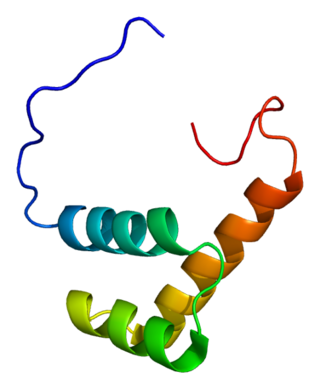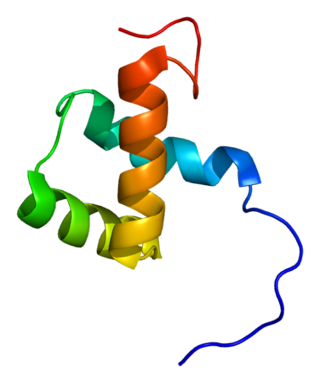Pituitary homeobox 3 is a protein that in humans is encoded by the PITX3 gene. [4] [5]
Pituitary homeobox 3 is a protein that in humans is encoded by the PITX3 gene. [4] [5]
This gene encodes a member of the RIEG/PITX homeobox family, which is in the bicoid class of homeodomain proteins. Members of this family act as transcription factors. This protein is involved in lens formation during eye development, [5] and the specification and terminal differentiation of mesencephalic dopamine neurons in the substantia nigra compacta that are lost in Parkinson's disease. [6]
Mutations of this gene have been associated with anterior segment mesenchymal dysgenesis (ASMD) and congenital cataracts. [5]

The substantia nigra (SN) is a basal ganglia structure located in the midbrain that plays an important role in reward and movement. Substantia nigra is Latin for "black substance", reflecting the fact that parts of the substantia nigra appear darker than neighboring areas due to high levels of neuromelanin in dopaminergic neurons. Parkinson's disease is characterized by the loss of dopaminergic neurons in the substantia nigra pars compacta.

The nuclear receptor 4A2 (NR4A2) also known as nuclear receptor related 1 protein (NURR1) is a protein that in humans is encoded by the NR4A2 gene. NR4A2 is a member of the nuclear receptor family of intracellular transcription factors.

Homeobox expressed in ES cells 1, also known as homeobox protein ANF, is a homeobox protein that in humans is encoded by the HESX1 gene.

Zinc finger E-box-binding homeobox 2 is a protein that in humans is encoded by the ZEB2 gene. The ZEB2 protein is a transcription factor that plays a role in the transforming growth factor β (TGFβ) signaling pathways that are essential during early fetal development.

Homeobox protein MSX-1, is a protein that in humans is encoded by the MSX1 gene. MSX1 transcripts are not only found in thyrotrope-derived TSH cells, but also in the TtT97 thyrotropic tumor, which is a well differentiated hyperplastic tissue that produces both TSHß- and a-subunits and is responsive to thyroid hormone. MSX1 is also expressed in highly differentiated pituitary cells which until recently was thought to be expressed exclusively during embryogenesis. There is a highly conserved structural organization of the members of the MSX family of genes and their abundant expression at sites of inductive cell–cell interactions in the embryo suggest that they have a pivotal role during early development.

Paired-like homeodomain transcription factor 2 also known as pituitary homeobox 2 is a protein that in humans is encoded by the PITX2 gene.

Homeobox protein MSX-2 is a protein that in humans is encoded by the MSX2 gene.

Homeobox protein Hox-A1 is a protein that in humans is encoded by the HOXA1 gene.

Zinc finger E-box-binding homeobox 1 is a protein that in humans is encoded by the ZEB1 gene.

Cone-rod homeobox protein is a protein that in humans is encoded by the CRX gene.

Paired mesoderm homeobox protein 2A is a protein that in humans is encoded by the PHOX2A gene.

Paired-like homeodomain 1 is a protein that in humans is encoded by the PITX1 gene.

Homeobox protein OTX2 is a protein that in humans is encoded by the OTX2 gene.

Homeobox protein SIX3 is a protein that in humans is encoded by the SIX3 gene.

Homeobox protein Emx2 is a protein that in humans is encoded by the EMX2 gene.

Visual system homeobox 1 is a protein that in humans is encoded by the VSX1 gene.

Homeobox protein OTX1 is a protein that in humans is encoded by the OTX1 gene.

Forkhead box protein E3 (FOXE3) also known as forkhead-related transcription factor 8 (FREAC-8) is a protein that in humans is encoded by the FOXE3 gene located on the short arm of chromosome 1.
Dopaminergic cell groups, DA cell groups, or dopaminergic nuclei are collections of neurons in the central nervous system that synthesize the neurotransmitter dopamine. In the 1960s, dopaminergic neurons or dopamine neurons were first identified and named by Annica Dahlström and Kjell Fuxe, who used histochemical fluorescence. The subsequent discovery of genes encoding enzymes that synthesize dopamine, and transporters that incorporate dopamine into synaptic vesicles or reclaim it after synaptic release, enabled scientists to identify dopaminergic neurons by labeling gene or protein expression that is specific to these neurons.
Gene therapy in Parkinson's disease consists of the creation of new cells that produce a specific neurotransmitter (dopamine), protect the neural system, or the modification of genes that are related to the disease. Then these cells are transplanted to a patient with the disease. There are different kinds of treatments that focus on reducing the symptoms of the disease but currently there is no cure.
{{cite journal}}: CS1 maint: unflagged free DOI (link)This article incorporates text from the United States National Library of Medicine, which is in the public domain.